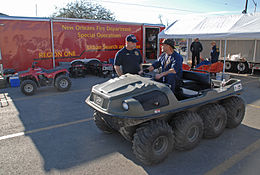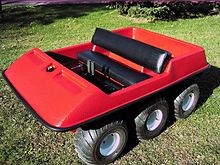
An amphibious vehicle is a vehicle that works both on land and on or under water. Amphibious vehicles include amphibious bicycles, ATVs, cars, buses, trucks, railway vehicles, combat vehicles, and hovercraft.

An all-terrain vehicle (ATV), also known as a light utility vehicle (LUV), a quad bike or quad, as defined by the American National Standards Institute (ANSI), is a vehicle that travels on low-pressure tires, has a seat that is straddled by the operator, and has handlebars. As the name implies, it is designed to handle a wider variety of terrain than most other vehicles. It is street-legal in some countries, but not in most states, territories and provinces of Australia, the United States, and Canada.

An off-road vehicle (ORV), sometimes referred to as an off-highway vehicle (OHV), overland vehicle, or adventure vehicle, is considered to be any type of vehicle that is capable of driving off paved or gravel surfaces, such as trails and forest roads that have rough and low traction surfaces.
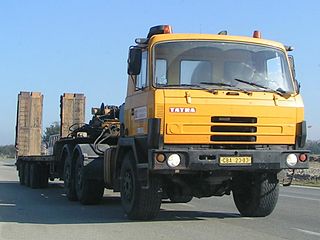
The Tatra 815 is a truck family, produced by Czech company Tatra. It uses the traditional Tatra concept of rigid backbone tube and swinging half-axles giving independent suspension. The vehicles are available in 4x4, 6x6, 8x8, 10x8, 10x10, 12x8 and 12x12 variants. There are both air-cooled and liquid-cooled engines available with power ranging from 230–440 kilowatts (310–590 hp). As a successor to Tatra 813 it was originally designed for extreme off-road conditions, while nowadays there are also variants designated for mixed use. The gross weight is up to 35,500 kg (78,264 lb).

A drive wheel is a wheel of a motor vehicle that transmits force, transforming torque into tractive force from the tires to the road, causing the vehicle to move. The powertrain delivers enough torque to the wheel to overcome stationary forces, resulting in the vehicle moving forwards or backwards.

Six-wheel drive is an all-wheel drive drivetrain configuration of three axles with at least two wheels on each axle capable of being driven simultaneously by the vehicle's engine. Unlike four-wheel drive drivetrains, the configuration is largely confined to heavy-duty off-road and military vehicles, such as all-terrain vehicles, armored vehicles, and prime movers.
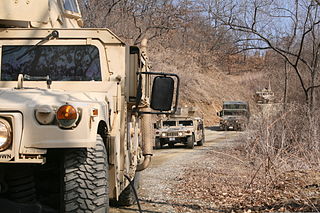
A military vehicle is any vehicle for land-based military transport and activity, including combat vehicles, both specifically designed for or significantly used by military. Most military vehicles require off-road capabilities and/or vehicle armor, making them heavy. Some have vehicle tracks instead of just wheels; half-tracks have both. Furthermore, some military vehicles are amphibious, constructed for use on land and water, and sometimes also intermediate surfaces.
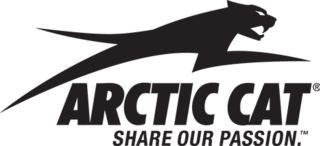
Arctic Cat is an American brand of snowmobiles and all-terrain vehicles manufactured in Thief River Falls, Minnesota. The company was formed in 1960 and is now part of Textron Inc. Arctic Cat designs, engineers, manufactures, and markets all-terrain vehicles, snowmobiles and related parts, garments—such as snowmobile suits—and accessories.

The Pandur II is an improved modular all-wheel-drive version of the Pandur 6x6 APC wheeled armoured vehicle. It was developed as a private venture by the Austrian company Steyr-Daimler-Puch Spezialfahrzeuge. Steyr-Daimler-Puch Spezialfahrzeuge is part of General Dynamics European Land Systems (GDELS), which is also the parent company of MOWAG of Switzerland and Santa Bárbara Sistemas of Spain.
Stompers are battery-powered toy cars that use a single AA battery and feature four-wheel drive. They are driven by a single motor that turns both axles. They were the first battery-powered, electric, true 4WD toys. Stompers were created in 1980 by A. Eddy Goldfarb and sold by Schaper Toys. Later, in the United Kingdom, Corgi Toys marketed identical toys in Corgi labeled packaging called Trekkers but made by Schaper. Genuine Stompers were sold by various companies around the globe and were also made by Schaper. There were similar products manufactured by Soma and LJN. Both companies were involved in lawsuits by Goldfarb and Schaper. Settlements were made and the companies continued their line of toys. As of 2019, Goldfarb continues to live and work at his design studio in Southern California.

An articulated hauler, articulated dump truck (ADT), or sometimes a dump hauler, is a very large heavy-duty type of dump truck used to transport loads over rough terrain, and occasionally on public roads. The vehicle usually has all-wheel drive and consists of two basic units: the front section, generally called the tractor, and the rear section that contains the dump body, called the hauler or trailer section. Steering is made by pivoting the front in relation to the back by hydraulic rams. This way, all wheels follow the same path, making it an excellent off-road vehicle.

The Amphicat is a six-wheel-drive, skid steer amphibious all-terrain vehicle, one of whose developers was Spanish inventor and businessman José Artés de Arcos, whose company produced the model in Spain. Manufactured in the late 1960s through the early 1970s by Mobility Unlimited Inc. of Auburn Hills, Michigan, the product line was purchased by Magna American which produced the vehicle in Raymond, Mississippi for several years. The vehicle was also made in Canada by Behoo Industries and differed slightly from its American counterpart, mostly on the transom.

Eight-wheel drive, often notated as 8WD or 8×8, is a drivetrain configuration that allows all eight wheels of an eight-wheeled vehicle to be drive wheels simultaneously. Unlike four-wheel drive drivetrains, the configuration is largely confined to heavy-duty off-road and military vehicles, such as armored vehicles, tractor units or all-terrain vehicles such as the Argo Avenger.

A side-by-side vehicle, is an off-road vehicle with a minimum of two seats positioned side by side and enclosed within a roll cage structure. They have a minimum of four wheels and are operated by foot controls and a steering wheel. Depending on use and application they can also be called a utility task vehicle, utility terrain vehicle (UTV), recreational off-highway vehicle (ROV), or multipurpose off-highway utility vehicle (MOHUV).

FAP 2026 is a general purpose off-road lorry made by Serbian vehicle manufacturer Fabrika automobila Priboj (FAP). The six-wheel drive lorry is designed for transport of personnel, weapons and material up to 6 tons of total weight, as for traction of weapons and trailer up to 7.2 tons of weight for the needs of the Yugoslav People's Army.

Argo is a Canadian manufacturer of amphibious all-terrain vehicles. It was founded in 1962 as Ontario Drive and Gear (ODG) Limited, in Kitchener, Ontario and was later moved to New Hamburg, Ontario. Argo offers 6×6 and 8×8 amphibious extreme terrain vehicles, as well as 4 wheel ATVs.

An amphibious automobile is an automobile that is a means of transport viable on land as well as on or under water. They are unarmored for civilian use.
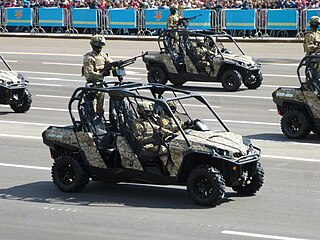
Can-Am is a Canadian subsidiary of Bombardier Recreational Products, once part of Bombardier Inc. Its products include ATVs and side-by-side vehicles. It was founded in 1942 as L'Auto-Neige Bombardier Limitée by Joseph-Armand Bombardier in Valcourt, Quebec, Canada.

Lynx is a series of lightweight all-terrain vehicle with 8x8, 6x6, or 4x4 all wheel drive. The vehicle is amphibious and capable of center-turning. Militarized version were observed in 2008 with reinforced chassis, weapon mounts, storage space and roll cage. The vehicle has different layout for different mission set, including troop transport, logistics, heavy weapon platform, reconnaissance, air defense, engineering service, or medical evacuation. During airborne, quick reaction and special forces operations this vehicle can be launched by tactical airlift or transport helicopters, or helicopter sling load.

